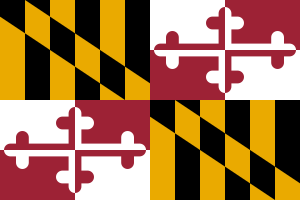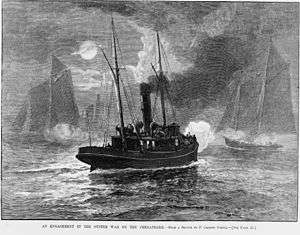Maryland Department of Natural Resources Police
The Maryland Natural Resources Police (NRP) is the law enforcement arm of the Maryland Department of Natural Resources (DNR). Natural Resources Police Officers patrol state-owned lands and enforce conservation and boating laws as well as Maryland's Criminal Law and Transportation Article. NRP is also the primary law enforcement agency on the waterways of Maryland and is the primary response agency for all homeland security threats on Maryland waterways.
| Maryland Natural Resources Police | |
|---|---|
 | |
 Flag of the State of Maryland | |
| Abbreviation | NRP |
| Agency overview | |
| Formed | 1868 |
| Preceding agencies |
|
| Jurisdictional structure | |
| Operations jurisdiction | Maryland, U.S. |
| General nature | |
| Operational structure | |
| Headquarters | Annapolis, Maryland, U.S. |
| Sworn members | 262 |
| Unsworn members | 78 |
| Agency executive |
|
| Website | |
| www | |
Natural Resources Police officers are the only police officers to have statewide jurisdiction, including Baltimore City. (The Maryland State Police (MSP), which is the state police and highway patrol, also has statewide jurisdiction, but have limited authority within Baltimore City).
As of March 30, 2016 the force had an authorized strength of 262 sworn personnel and 78 civilian employees.[1][2]
Training/authority
The NRP have statewide authority to enforce all laws, including the Natural Resources Article, the Criminal Law Article, and the Transportation Article.
The Maryland Natural Resources Police Training Academy, the agency police academy, is located in Sykesville, Maryland at Maryland Police and Correctional Training Commission.[3] The Academy officially opened on March 25, 1963 as the Maryland State Marine Police Academy, with a class of eight officers.[2]
History
The NRP is Maryland's oldest state law enforcement agency and fourth oldest state conservation law enforcement agency in the United States.[2][4]
The NRP traces its lineage to an act of the Maryland General Assembly in 1868 creating the State Oyster Police Force in order to enforce 1830 and 1865 laws regulating oyster-harvesting and conservation.[2] This forces' responsibility was limited to enforcing the oyster laws on the Chesapeake Bay.[2] Hunter Davidson, a former Confederate States Navy officer and U.S. Naval Academy graduate, was unanimously chosen as the first commander of the State Oyster Police Force by the State Board of Commissioners.[2] Davidson acquired a 12-pounder Dahlgren howitzer for the force's first steamer, Leila, for use in the gun battles between the Oyster Police and the illegal dredgers.[5][6]

During the early years the force, nicknamed the Oyster Navy, was engaged in suppressing oyster poaching by out of state boats and locals descrubed as "oyster pirates." During thse Oyster Wars the force had a fleet, largely of schooners such as Julia Hamilton but included armed steamers. The first steamer, Leila, was replaced by two built for the purpose, Governor R. M. McLane and Governor P. F. Thomas.[4][7] Governor R. M. McLane is known to have had a 12-pounder Dahlgren howitzer. Lt. Gregory Bartles of the Maryland Natural Resources Police believes that gun to have been transferred from Leila. The gun was acquired for eventual museum display by Maryland with funds from a donor matched by funds from the Department of Natural Resources Secretary.[6]
In 1874, the state created a Commission of Fisheries to study and report on the status of Maryland fisheries; the State Oyster Police Force was renamed the State Fishery Force and placed under the jurisdiction of the Commission.[2] In 1890, the state enacted its first uniform natural resources conservation law for the protection of game birds and animals.[2] In 1896, the General Assembly established the Office of the State Game Warden, headed by a state game warden appointed by the governor for a two-year term; Governor Lloyd Lowndes, Jr. appointed Robert H. Gilbert to the post.[2]
In 1916, the Conservation Commission was created by combining the State Fisheries Force and the Office of the State Game Warden; the General Assembly provided that the Commission could appoint the state game warden.[2] The Commission selected as its first appointment E. Lee LeCompte of Dorchester County, who served until 1945.[2]
Shortly after the nation's entry into World War I the Navy proposed that the State Fishery Force boats and personnel be used to maintain constant local patrols. The state legislature agreed that the boats and men of the state force would become part of the U.S. Naval Reserve providing they patrol the same districts for fisheries enforcement as well as federal interests with the benefit that patrol time would be increased and the expense for all be paid by the federal government. The vessels, some in commissioned status, served into 1918 in that dual role.[4][8] In 1918, the first statewide hunting license law was enacted, and in 1927, the first resident and nonresident angler's license law was enacted.[2]
In 2005, the Maryland DNR consolidated the law enforcement function of the Maryland Park Service's state park rangers (known as Maryland Rangers) into the Natural Resources Police, and many of the Maryland Rangers become NRP officers.[9] The NRP's mission expanded to include law enforcement duties for the state's parks, forests, and other lands managed by the DNR.[2] Maryland Park Service managers who had law enforcement responsibilities before the merger retained their law enforcement commissions and continued to be called Maryland Rangers. The park service hired non-law enforcement personnel, also to be referred to as rangers, to take over the non-law enforcement duties previously performed by the Maryland Rangers.[9]
Organization
The current superintendent (chief of police) is Colonel G. Adrian Baker
The DNR is divided into four regions:[10]
- Western (includes: Garrett, Allegany, Washington, and Frederick counties)
- Central (includes: Montgomery, Howard, Carroll, Harford, Cecil counties, and Baltimore County and Baltimore City)
- Southern (includes: Anne Arundel, Prince George's, Calvert, Charles, and St. Mary's counties)
- Eastern (includes: Kent, Queen Anne's, Caroline, Talbot, Dorchester, Somerset, Wicomico, and Worcester counties)
The NRP has its headquarters in the state capital, Annapolis.[11]
Divisions/units
The Maryland Natural Resources Police has several divisions and units, including but not limited to:[10]
- Field Operations Bureau (responsible for calls for service, enforcement)
- Special Operations Division (Tactical Response Team, K-9 Team, Underwater Operations Team, Homeland Security Section, Drug Enforcement Unit, High Intensity Drug Trafficking Area (HIDTA), Criminal Investigations Section, Background Investigations Section, etc.)
- Support Services (Academy, Academy Staff, Training Division, Quartermaster Division, Maintenance Division)
- In September 2013, NRP brought back their Cadet Program (13 Young Men and Women from the age of 18-20) after 20+ years.
- Reserve Officer Program. Reserve Officers are non-sworn officer volunteers who provide various types of support, education, training and public relations functions for the NRP.
References
- "Thirty-one Recruits Begin Natural Resources Police Academy". Maryland Department of Natural Resources. March 30, 2016. Retrieved 15 May 2020.
- "History — Natural Resources Police". Maryland Department of Natural Resources. Retrieved 15 May 2020.
- Training Facility List, Governor's Office of Crime Control & Prevention.
- "An Evolving Force: Natural Resources Police Celebrates 150th Anniversary". Maryland Department of Natural Resources. March 30, 2018. Retrieved 15 May 2020.
- "Oyster Wars Cannon Historical Sources". Maryland Department of Natural Resources. Retrieved 20 May 2020.
- Shapiro, Marc. "American Legion Sells Historic Cannon to Department of Natural Resources" (PDF). Retrieved 20 May 2020.
- Eighteenth Annual List of Merchant Vessels of the United States, Year ended June 30, 1886. Washington, D.C.: Bureau of Marine Inspection and Navigation. 1886. p. 327. Retrieved 15 May 2020.
- Conservation Commission of Maryland (1918). "Second Annual report of the Conservation Commission of Maryland — 1917": 9–10, 20. Retrieved 15 May 2020. Cite journal requires
|journal=(help) - "DNR Law Enforcement Unit Consolidation". Maryland Department of Natural Resources. 2005. Archived from the original on 2015-09-23. Retrieved 2015-04-12.
- "Staffing — NRP Regions Districts and Areas". Maryland Department of Natural Resources. March 3, 2020. Retrieved 15 May 2020.
- "Department of Natural Resources — Maryland Natural Resources Police (Directory)". State of Maryland (Maryland.gov). 2020. Retrieved 15 May 2020.